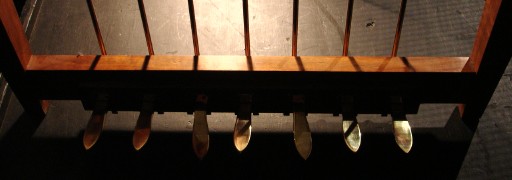Technical Library
RESOURCES III: First encounter with the twentieth-century harpsichord
Entire Contents Copyright © 2006 CBHTechnical LibraryRESOURCES III: First encounter with the twentieth-century harpsichord Entire Contents Copyright © 2006 CBH |
First encounter with the twentieth-century harpsichord…
Compared to the simplicity of the historic-style harpsichord, the twentieth-century or revival harpsichord could well appear intimidating. (If you are unsure of the differences, please refer to this page.) The revival harpsichord comes from an interesting era whose instruments are best portrayed in Wolfgang Zuckermann’s 1969 book The Modern Harpsichord.
The twentieth-century factory made harpsichord is characterized by wood veneer over heavy laminated case construction, open bottom, felt-bushed piano-sized keys, hard steel strings, complex jacks with leather plectra and adjustment screws, and often a 16´ choir which sounds an octave lower than unison pitch, usually piggybacked on the unison bridge and stifling its tone. These instruments are still to be found around the world, but their value is reduced because most players find them out of fashion, lacking the richness and resonance of a good historic-style harpsichord, and difficult to maintain.
 CAREY BEEBE |
| Row of foot pedals on a 1969 Robert Goble harpsichord |
The registers on the modern harpsichord are often controlled by a row of pedals like those shown in the photo. Left to right these pedals control the following:
When all the pedals are in their UP position, the lower keyboard is silent, and the upper keyboard plays the usual front 8´ choir of jacks. (Depressing pedal 6 will substitute the very nasal, close plucking lute row of jacks for the upper keyboard.) The photo shows the instrument in a common playing disposition with pedals 3 & 5 in the ENGAGED position: Both unision choirs are on their expected keyboards, and the upper keyboard is coupled to the lower. The full harpsichord sound with all choirs would be obtained by putting pedals 2, 3, 4 & 5 in the ENGAGED position.
| Technical Library overview | |
| Harpsichords Australia Home Page |